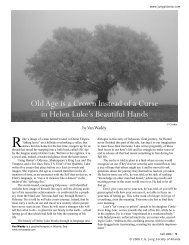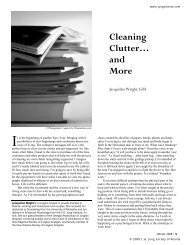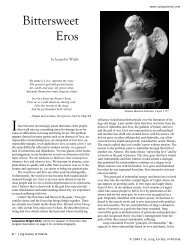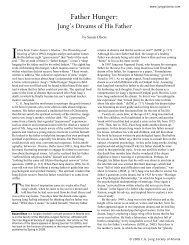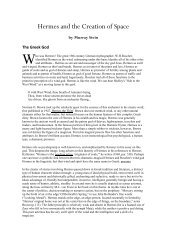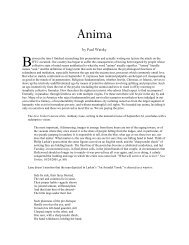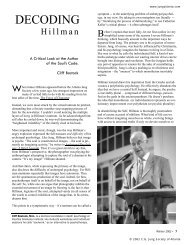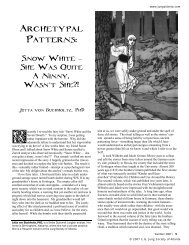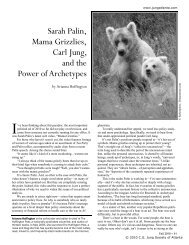Tears: Connection to the Source - C.G. Jung Society of Atlanta
Tears: Connection to the Source - C.G. Jung Society of Atlanta
Tears: Connection to the Source - C.G. Jung Society of Atlanta
Create successful ePaper yourself
Turn your PDF publications into a flip-book with our unique Google optimized e-Paper software.
<strong>Tears</strong>:<br />
<strong>Connection</strong><br />
<strong>to</strong> <strong>the</strong> <strong>Source</strong><br />
by Jutta von Buchholtz<br />
N<br />
ot long ago I spent some time <strong>of</strong> every day, for weeks<br />
and months, crying. <strong>Tears</strong> forced <strong>the</strong>mselves in<strong>to</strong> my<br />
consciousness, insisting I pay attention. <strong>Jung</strong>ian analyst<br />
Marie-Louise von Franz proposed that going down and in<strong>to</strong> a<br />
depression is <strong>of</strong>ten <strong>the</strong> only way out <strong>of</strong> it. Consequently, I have<br />
scoured <strong>the</strong> literature regarding tears while I followed <strong>the</strong> salty<br />
traces <strong>of</strong> my own, my friends’ and my clients’ weeping. This<br />
little article is <strong>the</strong> distillate, <strong>the</strong> result <strong>of</strong> our outpourings – it also<br />
became a transformative catharsis.<br />
In <strong>the</strong> course <strong>of</strong> writing this paper, I have been looking at a picture:<br />
a poster <strong>of</strong> Pablo Picasso’s painting “Weeping Woman”.<br />
At first I saw only a confusing jumble, parts <strong>of</strong> a woman’s face<br />
fractured in uncontrollable emotional pain – but as I lived with<br />
<strong>the</strong> painting – and with my <strong>to</strong>pic “<strong>Tears</strong>” – <strong>the</strong> jumble became<br />
clearer and some aspects <strong>of</strong> both, <strong>the</strong> painting and my <strong>to</strong>pic,<br />
started <strong>to</strong> delineate <strong>the</strong>mselves. I want <strong>to</strong> describe <strong>the</strong> painting:<br />
almost all <strong>of</strong> <strong>the</strong> canvas is taken up by <strong>the</strong> life size head and<br />
neck, in pr<strong>of</strong>ile, <strong>of</strong> a weeping woman, tears flowing uns<strong>to</strong>ppably<br />
out <strong>of</strong> her eyes, down her face, cheek and nose a watery pink.<br />
Her mouth is open, teeth bared in archaic, dumb pain. A black<br />
frayed <strong>to</strong>ngue protrudes, and a large, white procession <strong>of</strong> shapes<br />
progresses <strong>to</strong>wards <strong>the</strong> gray background and on <strong>to</strong>wards a black,<br />
primitive cave. The pale shapes look like unshea<strong>the</strong>d penises, or<br />
crumpled handkerchiefs, ready <strong>to</strong> catch <strong>the</strong> overflow <strong>of</strong> frenzied<br />
emotions – <strong>the</strong>y also remind me <strong>of</strong> old fashioned nuns’ or<br />
nurses’ hoods as <strong>the</strong>y move <strong>to</strong>wards <strong>the</strong> consuming black hole, a<br />
dark, ominous opening which threatens <strong>to</strong> swallow <strong>the</strong> weeping<br />
person. It is a scary painting – even if one does not know that it<br />
depicts one <strong>of</strong> Picasso’s many mistresses in <strong>the</strong> grips <strong>of</strong> disintegrating<br />
“amour fou”, a love that goes crazy when it is threatened<br />
by <strong>the</strong> loss <strong>of</strong> <strong>the</strong> love object. The image also conveys <strong>the</strong> sense<br />
<strong>of</strong> anxiety we feel in our tearless, rational twentieth century <strong>to</strong>wards<br />
all emotions: we fear mental breakdowns, chaotic loss <strong>of</strong><br />
control and tears are evidence that we are in <strong>the</strong> murky vicinity<br />
<strong>of</strong> all this “stuff”. Let’s run in <strong>the</strong> opposite direction!<br />
Webster’s dry definition <strong>of</strong> tears as product <strong>of</strong> <strong>the</strong> lachrymal<br />
glands does not do any justice <strong>to</strong> <strong>the</strong> soggy reality <strong>of</strong> weeping.<br />
<strong>Tears</strong> are messy: crying produces swollen eyelids, smeared mas-<br />
Jutta von Buchholtz will lecture <strong>to</strong> <strong>the</strong> <strong>Jung</strong> <strong>Society</strong> on June 22.<br />
Biographical information and lecture description can be found on<br />
page 3<br />
www.jungatlanta.com<br />
cara, pinkish snotty noses, splotchy complexion etc. The veil <strong>of</strong><br />
tears clouds our vision: we can’t “really” see. We are embarrassed<br />
if we cry in public and <strong>of</strong>ten we have no idea why our<br />
cups slosh over. We approach weeping with apprehension, as if<br />
it were <strong>the</strong> trumpet call <strong>to</strong> a dangerous loss <strong>of</strong> control, as if an<br />
outbreak <strong>of</strong> watery emotions could bring about a passionate loss<br />
<strong>of</strong> our comfortable Business-as-usual state <strong>of</strong> mind. We only<br />
seem <strong>to</strong> apprehend tears as evidence coming from some mysterious,<br />
unclear depth, and warily treat <strong>the</strong>m as if <strong>the</strong>y were signs <strong>of</strong><br />
impending or already accomplished disaster.<br />
A box <strong>of</strong> Kleenex in my library, where I meet with my clients,<br />
attests <strong>to</strong> <strong>the</strong> curious fact that, as a <strong>Jung</strong>ian analyst, tears are, so<br />
<strong>to</strong> speak, my business. <strong>Tears</strong> are made up <strong>of</strong> water and salt. After<br />
we have shed tears, <strong>the</strong> salt road down our cheeks beckons <strong>to</strong><br />
be traveled back <strong>to</strong> its wellspring - <strong>to</strong> its bitter if healing source.<br />
Pablo Picasso - Weeping Woman, 1937<br />
The healing power <strong>of</strong> tears is an archetypal <strong>the</strong>me. In <strong>the</strong> fairy<br />
tale by <strong>the</strong> same name, Rapunzel’s salty tears wash over her<br />
husband’s blinded eyes, curing him, res<strong>to</strong>ring his sight. At times<br />
<strong>the</strong> one shedding <strong>the</strong> tears is healed, as was Mary Magdalene<br />
who washed Jesus’ feet with her tears. Both Rapunzel’s prince<br />
and Mary Magdalene were made whole again. Our culture demands<br />
that we keep most tears out <strong>of</strong> sight and with that we<br />
forfeit a source <strong>of</strong> healing in <strong>the</strong> sense <strong>of</strong> wholeness. We <strong>of</strong>ten<br />
betray our inner healing power with a “healthy” adjustment <strong>to</strong><br />
<strong>the</strong> standards <strong>of</strong> <strong>the</strong> group we must fit ourselves in <strong>to</strong>.<br />
As a society we ascribe <strong>to</strong> reasonableness, dry sobriety, pleasure<br />
and pain “measured out in c<strong>of</strong>fee spoons”, and cool detachment.<br />
Spring 2002 • 5<br />
© 2002 C.G. <strong>Jung</strong> <strong>Society</strong> <strong>of</strong> <strong>Atlanta</strong>
When does our environment permit our eyes <strong>to</strong> flow over? We<br />
allow babies <strong>to</strong> weep, although <strong>the</strong>y are incapable <strong>of</strong> shedding<br />
tears until <strong>the</strong>y are a few weeks old. People may cry at funerals<br />
– women avail <strong>the</strong>mselves <strong>of</strong> <strong>the</strong> opportunity much more so than<br />
men. The brevity and matter <strong>of</strong> fact spirit <strong>of</strong> our funeral rites<br />
seems intended <strong>to</strong> stem <strong>the</strong> emotional outpouring <strong>of</strong> <strong>the</strong> bereaved<br />
ra<strong>the</strong>r than provide a safe container, a temenos, which<br />
would give space, dignity and respect <strong>to</strong> emotion. People are<br />
allowed <strong>to</strong> cry when <strong>the</strong>ir bodies are wounded, when <strong>the</strong>re is<br />
concrete pain. Men are more bereft <strong>of</strong> emotional expression<br />
than women when it comes <strong>to</strong> cultural permission <strong>to</strong> cry: <strong>the</strong>y<br />
make up <strong>the</strong> invisible, silent columns <strong>of</strong> tearless walking<br />
wounded.<br />
W<br />
e have a newcomer on our street: a single man who<br />
moved in<strong>to</strong> our neighborhood a couple <strong>of</strong> years ago.<br />
After he had been here for almost a year his fa<strong>the</strong>r<br />
died. A friend and I went <strong>to</strong> <strong>the</strong> funeral service. There were<br />
eulogies and testimonies <strong>to</strong> <strong>the</strong> deceased. His nephew, a handsome,<br />
bright young man delivered a speech. As he talked about<br />
his grandfa<strong>the</strong>r’s life, tears started <strong>to</strong> come and his words faltered.<br />
He acknowledged his state <strong>of</strong> disequilibrium but continued<br />
<strong>to</strong> talk movingly about his grandfa<strong>the</strong>r. His tears were not<br />
only evidence <strong>of</strong> <strong>the</strong> strong emotional ties between <strong>the</strong> two men,<br />
but as <strong>the</strong>y spilled over, despite his efforts at control, all <strong>of</strong> us<br />
now belonged, mysteriously, with <strong>the</strong> grieving – sharing a pr<strong>of</strong>ound<br />
and deeply human condition: no one was alone any<br />
longer; his healing tears bridged <strong>the</strong> distance between us and<br />
washed away <strong>the</strong> <strong>of</strong>ten unbearable sense <strong>of</strong> isolation and loneliness.<br />
Afterwards, a few weeks later, my neighbor and I talked<br />
about <strong>the</strong> funeral. He calmly commented on his nephew’s display<br />
<strong>of</strong> emotion as inappropriate, showing weakness and something<br />
that should have been prevented.<br />
Men have generally been condemned <strong>to</strong> a brittle, tearless life –<br />
women may cry, but <strong>of</strong>ten we carry <strong>the</strong> burden <strong>of</strong> our men’s<br />
unshed tears as well; we are considered weak when we allow<br />
our tears <strong>to</strong> flow. We are chided, even ridiculed for our emotional<br />
connectedness. Americans seldom welcome tears or <strong>the</strong><br />
hurt and sadness we usually associate with <strong>the</strong>m. Of all <strong>the</strong> emotions<br />
we are capable <strong>of</strong>, we split <strong>of</strong>f a mass <strong>of</strong> <strong>the</strong>m. We know<br />
we have a right <strong>to</strong> happiness – it says so in our Constitution. But<br />
where has our right <strong>to</strong> sadness and its wet companions gone?<br />
For that matter where are anger, worry, fear, envy, jealousy and<br />
all <strong>the</strong> o<strong>the</strong>r dark sisters and bro<strong>the</strong>rs when we look at all <strong>the</strong><br />
guests invited <strong>to</strong> our brightly lit and well-adjusted lives? The<br />
collective allows for a severely limited emotional range – anything<br />
outside this “healthy”, narrow band <strong>of</strong> smiley-faced dryness<br />
may even be labeled pathological and must lead a secret<br />
life, closeted away. Psychologically this is a dangerous situation.<br />
Whatever lives in <strong>the</strong> closet – ano<strong>the</strong>r word for <strong>the</strong> unconscious<br />
– develops a shadow life <strong>of</strong> it’s own, binds psychic energy, limits<br />
our creativity and is likely <strong>to</strong> erupt in<strong>to</strong> our lives with archaic,<br />
usually malevolent force. Like <strong>the</strong> thirteenth fairy in “Sleeping<br />
Beauty”, inner figures only become dangerous when <strong>the</strong>y are<br />
not invited. (Happens all <strong>the</strong> time <strong>to</strong> us when we are overlooked<br />
for invitations <strong>to</strong> parties, for promotions, in conversation etc.)<br />
Psychologically speaking, <strong>the</strong>se inner figures become repressed<br />
or suppressed content, captives <strong>of</strong> a host <strong>of</strong> defense mechanisms.<br />
We know, for example, that unshed tears can lead <strong>to</strong> unmanageable<br />
hysteria or a soulless, arid wasteland in <strong>the</strong> psyche and dis-<br />
6 • <strong>Jung</strong> <strong>Society</strong> <strong>of</strong> <strong>Atlanta</strong><br />
www.jungatlanta.com<br />
Pablo Picasso - Weeping Woman, 1937<br />
owned anger can readily turn in<strong>to</strong> violent rage and aggression. I<br />
want <strong>to</strong> be clear that I am not advocating acting out: quite <strong>the</strong><br />
contrary. By becoming conscious <strong>of</strong> our emotions our egos have<br />
<strong>the</strong> only chance <strong>of</strong> any control and humanizing interaction. On<br />
<strong>the</strong> level <strong>of</strong> diplomacy: if two countries break <strong>of</strong>f communications,<br />
sadly, war is only <strong>to</strong>o <strong>of</strong>ten <strong>the</strong> consequence.<br />
T<br />
he fountain <strong>of</strong> tears is grounded in wounds based on<br />
losses such as loss <strong>of</strong> innocence, persons, jobs, hopes,<br />
youth, health etc. But wounds also constitute openings<br />
<strong>of</strong> <strong>the</strong> surface. They provide a salty access road <strong>to</strong> what is more<br />
than skin deep. <strong>Jung</strong>ians understand life through images –<br />
whe<strong>the</strong>r <strong>the</strong>se images present <strong>the</strong>mselves in dreams or during<br />
waking hours. These images, unders<strong>to</strong>od as symbols, establish a<br />
connection between consciousness, <strong>the</strong> house <strong>of</strong> <strong>the</strong> ego, and <strong>the</strong><br />
deeper layers <strong>of</strong> <strong>the</strong> personal and/or collective unconscious,<br />
home <strong>of</strong> <strong>the</strong> complexes and archetypes. Libido, precious life<br />
energy, is rooted in and wells up from <strong>the</strong> unconscious. That is<br />
why we so need <strong>to</strong> have communications and creative interplay<br />
between <strong>the</strong>se two psychic spheres. Much <strong>of</strong> our life energy is<br />
tied up with <strong>the</strong> shadow - personal as well as collective - and is<br />
out <strong>of</strong> eyesight. Following our individual trail <strong>of</strong> tears, allowing<br />
feelings <strong>to</strong> bubble up in<strong>to</strong> consciousness, is <strong>the</strong> only chance we<br />
have <strong>of</strong> avoiding <strong>the</strong> destructive, shadowy aspect <strong>of</strong> emotions.<br />
We are afraid <strong>of</strong> emotionality in many Western societies, but<br />
especially so in <strong>the</strong> United States: it is messy and any messiness<br />
bugs us. Americans are well known for <strong>the</strong>ir penchant for disinfectants,<br />
antibiotics, bug sprays etc. Murky depths, things we do<br />
not understand, unpredictable confusion, mystery … most <strong>of</strong> us<br />
prefer not <strong>to</strong> be surprised or confused by and about most things.<br />
We ascribe <strong>to</strong> a risk free life, a relatively manageable, mess-free,<br />
easy, if passionless life. We have no patience for walking along<br />
any bluesy, dismal road. We insist on living almost exclusively<br />
on <strong>the</strong> sunny side <strong>of</strong> <strong>the</strong> street. It is not unusual that it can take<br />
© 2002 C.G. <strong>Jung</strong> <strong>Society</strong> <strong>of</strong> <strong>Atlanta</strong>
many months and dozens <strong>of</strong> watery hours in analysis <strong>to</strong> shed <strong>the</strong><br />
tears we were meant <strong>to</strong> shed but didn’t at an earlier time. Carl<br />
<strong>Jung</strong> thought modern man’s true illness was our loss <strong>of</strong> soul.<br />
Perhaps we can bind back split <strong>of</strong>f parts <strong>of</strong> ourselves on <strong>the</strong> bitter<br />
salt road <strong>of</strong> our tears. This would mean inviting all <strong>of</strong> our<br />
emotions in<strong>to</strong> consciousness. Senior <strong>Jung</strong>ian Analyst Adolf<br />
Guggenbuhl-Craig once said <strong>to</strong> me that <strong>the</strong> function <strong>of</strong> analysis<br />
is <strong>to</strong> live life more passionately, with occasional periods <strong>of</strong> reflection!<br />
H<br />
aving focused primarily on tears that flow due <strong>to</strong> loss<br />
and sadness and on <strong>the</strong>ir connection <strong>to</strong> <strong>the</strong> neglected,<br />
dark wellspring <strong>of</strong> emotions in our arid lives … what<br />
about <strong>the</strong> much more acceptable tears <strong>of</strong> joy? While I was<br />
working on this paper, <strong>the</strong> Olympic Games were going on in<br />
Salt Lake City. Being swept up in <strong>the</strong> <strong>to</strong>pic <strong>of</strong> tears, I noticed<br />
how much crying went on in very public places. The world<br />
watched strong young women and men shed tears <strong>of</strong> frustration<br />
and disappointment – yes, I could understand that because those<br />
were tears <strong>of</strong> loss <strong>of</strong> dreams and hopes. Stunningly <strong>of</strong>ten,<br />
though, <strong>the</strong>se heroic, cool athletes wept – at times uncontrollably<br />
- AFTER <strong>the</strong>y had won, at a peak point <strong>of</strong> happiness and<br />
accomplishment, at a time <strong>of</strong> being not only accepted, even venerated.<br />
Olympic medals were <strong>of</strong>ten awash in tears. One athlete<br />
said, “… something gave … in” about his tears. Ano<strong>the</strong>r admitted<br />
<strong>to</strong> being “… convulsed by tears…” Many said <strong>the</strong>y were “…<br />
overcome…” The flow <strong>of</strong> tears crossed national, sexual and<br />
racial boundaries. Why would anyone make a public display <strong>of</strong><br />
very private emotions having arrived in heaven, so <strong>to</strong> speak?<br />
Can intense happiness become <strong>to</strong>o painful and open <strong>the</strong> floodgates<br />
for tears? I became very aware <strong>of</strong> how close joy and sadness<br />
are and how intense experience <strong>of</strong> ei<strong>the</strong>r, but especially if<br />
both come <strong>to</strong>ge<strong>the</strong>r, can spill over in<strong>to</strong> tears.<br />
In our pain and sadness as well as in our joy, we feel intensely<br />
alive. I want <strong>to</strong> present a few examples – o<strong>the</strong>r than <strong>the</strong> Olympic<br />
Games - from my personal life, as well as from my consulting<br />
room, <strong>to</strong> amplify this insight. At times lovemaking has <strong>to</strong>uched<br />
me so pr<strong>of</strong>oundly, that I melted down in tears afterwards. Nothing<br />
said or done in those moments <strong>of</strong> intensity and grace could<br />
hurt me. O<strong>the</strong>r women have <strong>to</strong>ld me similar s<strong>to</strong>ries. Women<br />
have also talked <strong>to</strong> me about <strong>the</strong> moment <strong>of</strong> birth. It connected<br />
<strong>the</strong>m <strong>to</strong> <strong>the</strong> greater rhythmical music <strong>of</strong> <strong>the</strong> universe. They became<br />
co-crea<strong>to</strong>rs and <strong>the</strong>y laughed and cried all at <strong>the</strong> same<br />
time. Pain and joy were united in a peak experience, life was<br />
whole, and tears and laughter could create an emotional rainbow<br />
for one fleeting moment. There was nothing <strong>to</strong> be afraid <strong>of</strong>, no<br />
danger, and no lonesomeness. Instead, <strong>the</strong>re was a blissful sense<br />
<strong>of</strong> containment, and <strong>the</strong> pervasive knowledge <strong>of</strong> being part <strong>of</strong> a<br />
far greater mystery.<br />
Perhaps this experience <strong>of</strong> being at <strong>the</strong> fountain <strong>of</strong> wholeness<br />
concomitant with <strong>the</strong> acute consciousness, that it won’t last any<br />
time at all, that we are bound <strong>to</strong> have <strong>to</strong> leave heavenly paradise<br />
again, brings about this remarkable sense <strong>of</strong> passionate, intense<br />
aliveness – <strong>the</strong> bliss Joseph Campbell talks about which we<br />
must be on <strong>the</strong> search for. I understand this bliss <strong>to</strong> mean living<br />
our fullness, in blissful tears <strong>of</strong> joy as well as bitter ones <strong>of</strong> loss<br />
and sadness. Life may not be only about understanding, becoming<br />
conscious, – but/and also about living it passionately and<br />
fully, with tears <strong>of</strong> joy as well as sadness, as <strong>of</strong>ten as we can ■<br />
www.jungatlanta.com<br />
Spring 2002 • 7<br />
© 2002 C.G. <strong>Jung</strong> <strong>Society</strong> <strong>of</strong> <strong>Atlanta</strong>




